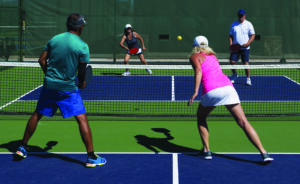 Few places can outshine Hawai‘i when it comes to healthy outdoor activities. The weather and the environment provide countless opportunities for exercise, whatever your fitness level. Canoe paddling challenges the physically fit, just as a short walk in a park or on a beach might challenge someone who has mobility issues. One sport that welcomes all fitness levels is pickleball.
Few places can outshine Hawai‘i when it comes to healthy outdoor activities. The weather and the environment provide countless opportunities for exercise, whatever your fitness level. Canoe paddling challenges the physically fit, just as a short walk in a park or on a beach might challenge someone who has mobility issues. One sport that welcomes all fitness levels is pickleball.
Pickleball has been booming in popularity in the islands for the past decade. Its growth has largely been a grassroots effort by players volunteering their time and effort to ensure that all levels of ability and commitment to the sport are accommodated. For some players, the social aspect is their motivator; for others it is a chance to test their skills in competitive and tournament play. The game is especially suitable for seniors, not just for the physical health benefits it provides but also for the opportunity to socialize and the mental exercise involved in keeping focused and in keeping score. If you’re curious about the game, please join me in finding out more about it.
When you ask people why they play pickleball, the answer always includes the word: Fun! Those three letters embody the spirit in which the game was created back in 1965 on Bainbridge Island in Washington state. The island is a favorite for family summer vacations but the weather isn’t always suitable for the beach. One cold damp day, neighbors Bill Bell and Joe Pritchard took their kids to the Pritchards’ small backyard badminton court with some ping pong paddles and a plastic wiffleball, and made up a game for them all to play. The kids loved the new game, and so did the adults! Another neighbor, Barney McCallum, joined in and the three friends made up the rules of the game on the fly.
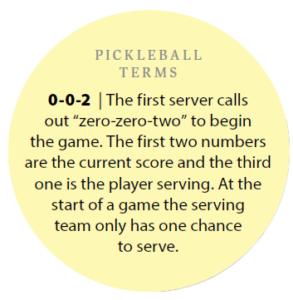 Pickleball — perhaps named for a family dog called Pickle — was strictly a family recreation until summer ended and everyone went back home to Seattle. Barney McCallum created a pickleball court on the street where he lived; Joe Pritchard incorporated a game of pickleball at his campaign rallies when he was running for Congress; and Father Fitterer, another visitor to the island and then president of Seattle University, started a pickleball night at the university’s new gym when it opened in 1969. As word of the game spread and people discovered how much fun it was, the demand for the plywood pickleball paddles Barney was making became so great that he incorporated a business to handle it in 1972. Pickle-Ball Inc. is still a major supplier of pickleball equipment, which has changed considerably over the past 50-plus years.
Pickleball — perhaps named for a family dog called Pickle — was strictly a family recreation until summer ended and everyone went back home to Seattle. Barney McCallum created a pickleball court on the street where he lived; Joe Pritchard incorporated a game of pickleball at his campaign rallies when he was running for Congress; and Father Fitterer, another visitor to the island and then president of Seattle University, started a pickleball night at the university’s new gym when it opened in 1969. As word of the game spread and people discovered how much fun it was, the demand for the plywood pickleball paddles Barney was making became so great that he incorporated a business to handle it in 1972. Pickle-Ball Inc. is still a major supplier of pickleball equipment, which has changed considerably over the past 50-plus years.
Pickleball is the fastest-growing sport in the US according to a randomized research survey done by YouGov in August 2022. They found that 14% of the 2,500 adults aged 18 and over that they surveyed had played the game at least once in the previous 12 months. That figure extrapolates to 36.5 million people nationwide. So it’s not surprising that a plethora of businesses have sprung up around the sport. Many cater to tournament players — there is even a professional league only
for players aged 50 and over.
But you don’t have to buy the high-end equipment the professionals use. Paddles can be found for less than $30 online. More expensive options may include a net, two paddles, two outdoor and two indoor pickleballs. Outdoor pickleballs have smaller holes to offset the effects of the wind — definitely a game “hazard” in Hawai‘i! Besides the larger holes, indoor pickleballs are usually a bit softer and a different color, making them easier to see in a gym environment.
The only other equipment needed to get started is a pair of sports shoes suitable for wear on an outdoor court, such as tennis shoes. (Running, walking and crosstraining shoes are not suitable for pickleball because they are designed for movement in one direction only.) If you intend to play indoors, the shoes you buy should be designed for play on hardwood or smooth composite surfaces. For both indoor and outdoor play, safety glasses made for pickleball are recommended. Add in a sun hat, visor or cap, a large bottle for water to keep you hydrated, some snacks to keep up your energy and you’re all set!
As with all new activities you want to add to your health routines, you should check first with your healthcare team whether pickleball is suitable for you. It does come with some risk of injury, especially for those new to exercise or racquet sports. Travis Lytle, physical therapist at IMUA PT on Maui, recommends “5 to 10 minutes of stretching the calves and hamstrings to help minimize the chances of a pulled hammy or developing plantar fasciitis (foot/heel pain).” He also recommends “working on light gripping (a sponge or small ball) for 2 to 3 minutes a few times a day to help improve forearm strength for those not used to holding onto a racquet for 45 to 60 minutes.” He adds that “The quickest way to develop ‘tennis elbow’ is not prepping the muscles for repetitive use during pickleball or tennis.” And, as with starting any new sport or gym routine, he highly recommends “easing into the new activity slowly as it will decrease your chance of injury.”
Where do I find a game?
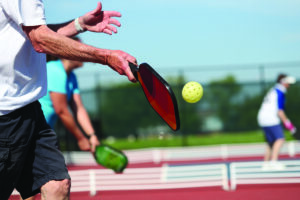 It would also be a good idea to go watch some games, as speaking with players at your local court can give you a better sense of what’s involved. Most pickleball courts — both indoor and out — are maintained by your local county’s parks and recreation department, and a quick call to them can help you find places and times that pickleball is being played. USA PIckle Ball, the nonprofit national governing body for the sport, has local players volunteer to update an easily searchable website called Places2Play: places2play.org. Each location is tagged with information about hours and whether it is free to play or has a drop-in or membership fee. Other tags to look out for are “Beginners Welcome,” “Recreational Focused” and “Senior Crowd.” There will often also be a contact number to connect you with a local player who can give you more specific details.
It would also be a good idea to go watch some games, as speaking with players at your local court can give you a better sense of what’s involved. Most pickleball courts — both indoor and out — are maintained by your local county’s parks and recreation department, and a quick call to them can help you find places and times that pickleball is being played. USA PIckle Ball, the nonprofit national governing body for the sport, has local players volunteer to update an easily searchable website called Places2Play: places2play.org. Each location is tagged with information about hours and whether it is free to play or has a drop-in or membership fee. Other tags to look out for are “Beginners Welcome,” “Recreational Focused” and “Senior Crowd.” There will often also be a contact number to connect you with a local player who can give you more specific details.
One thing to ask about is “Open Play.” In keeping with pickleball’s origins as a family and neighborhood activity promoting friendship and fun, Open Play is a way of welcoming everyone to play, no matter their age or skill level. It might be done via a sign-in sheet or by having players place their paddle (with their name on the handle) in a stack with up to three other paddles. As a court becomes available, the next four players in line get their turn.
A game usually lasts about 15 to 25 minutes, so it is quite a quick turnaround of players. It’s not unusual for players to stay for several games, socializing and maybe sharing a potluck while waiting for their next turn on the court. Numerous research studies have shown that being out among people enjoying a good time together is very beneficial for your health.
Pickleball is a game of focus, quick reflexes, and strategy, but doesn’t rely so much on strength and extreme agility. In fact, many players who have come to the game after playing another court sport — such as tennis or volleyball — are surprised to find themselves beaten by players far less athletic than they are. A short person, overweight and maybe even wearing a knee brace can best a tall, fast-moving player simply by knowing where to position themselves and by keeping relatively still but placing the ball strategically so that their opponent has to reach down to return it. Adjusting to the small dimensions of the court can be a challenge for some players used to ranging over the larger area of a tennis court.
The game begins by deciding which player or team has first choice of the side of the court they’ll be playing on and whether they will serve or receive. The first serve is always made diagonally from behind the back line of the right side of the court and it follows the two-bounce rule. The receiving team must let the ball bounce before returning it and the serving team must then also let it bounce before returning it. The aim of this rule is to extend rallies by eliminating an opening volley that may be impossible to return. After this opening play, both teams can either play the ball off a bounce (ground stroke) or volley it.
Many pickleball players also play tennis or did so in their younger days, but the two games are quite different. Tennis favors using a long backward sweep of the arm (backstroke) in order to give power to the ball’s return. Pickleball favors a smaller backswing because the court is so much smaller, requiring quick returns. The net is also lower: 36 inches at the sideline and 34 inches in the middle. (When the game was first created on a badminton court, the net’s new height was measured by one of the parents putting it at the height of their hip.) The dimensions of a pickleball court are 44 feet by 20 feet, the same as a badminton court.
You can never hit a volley from within 7 feet of the net, or even have your body’s momentum carry you into that non-volley zone (aka “the kitchen”) after your volley. Again, this rule dates from the time the game was invented as a family game. Standing close to the net makes volleying too easy, putting the defender at an unfair disadvantage and ruining the fun of the game. A summary of the most important rules can be found on the USA Pickleball website: usapickleball.org/what-is-pickleball/official-rules/rules-summary/.
Tennis uses an overhand serve but pickleball serves are always underhand and the contact point of the ball on the paddle must be below your waist, with the highest
point of the paddle being below your wrist. You only get one chance to get your serve into play, whereas in tennis you get two chances. Only the serving team can score points, and the two players in the serving team switch sides of the court after each point is won.
The Pickleheads website has a succinct, illustrated page showing how to play the game here: pickleheads.com/blog/how-to-play-pickleball. There are also hundreds of videos on YouTube showing you how to up your game skills, but the better option is to attend a coaching clinic. What works for someone else might not work for you in terms of technique and avoiding injury. Clinics may be offered by your local county Parks & Recreation Department (often for free) or by a local pickleball club for a fee. For example, the O‘ahu Pickleball Association (OPA) has weekly group lessons for Newbies (nets, balls and paddles included), Beginners, Advanced Beginners and Intermediate. You can find the details about all these clinics on the OPA website: oahupickleballassociation.org/learn-pickleball/classes-clinics-workshops/.
Many of the common mistakes made by beginners occur because the smaller dimensions of a pickleball court call for strategies that go against what you instinctively want to do.
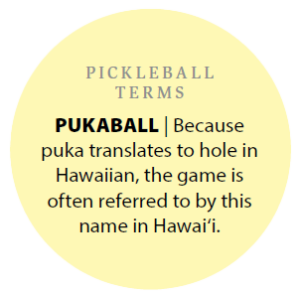 The “no man’s land” between the kitchen line and the baseline may seem like a good place to stand but playing from there can make it easier for your opponent to return your shot. If they place their shot behind you, there’s also a risk that you will stumble and fall as you run back to try to return it.
The “no man’s land” between the kitchen line and the baseline may seem like a good place to stand but playing from there can make it easier for your opponent to return your shot. If they place their shot behind you, there’s also a risk that you will stumble and fall as you run back to try to return it.
While it’s tempting to return a shot coming at you at head or shoulder height, the ball is more than likely going to go out-of-bounds, so you should just let it go by.
It is also very easy to step into “the kitchen” when following through on a shot, which will incur a fault.
As a beginner, you are still developing an understanding of the game and developing your own individual style of play. It’s a good time to practice a variety of shots so that you have the element of surprise on your side, rather than playing predictably. Remember to keep your eye on the ball and to be mindful of where it is relative to your paddle so that you can anticipate making the best return shot. Communicate with your partner, especially when a return shot could be taken by either of you. Don’t poach a shot from them by jumping over the center line into their side of the court — at the very least, you are leaving your side of the court wide open and undefended for your opponent’s return shot.
Once you’ve learned the game, you might like to return to its Bainbridge Island roots by creating a pickleball court in your yard or chalking one up on the street—if it’s a quiet one! But even if you don’t have the desire to get fully immersed in the game, investing in a paddle and some balls is a good health choice to make. A 12-year-long statistical study done by researchers at the National Cancer Institute and the National Institute on Aging, published in 2022, found that of all the activities older people can do to minimize the risk of early mortality, racquet sports are one of the most beneficial. That is because they require synchronized action from many muscles for correct form, hand-eye coordination, and intermittent bursts of very high intensity. These benefits, combined with the social element and mental exercise, are what make pickleball clubs eligible for affiliation with the Blue Zones Project, which promotes healthy lifestyles.
A final word
The final word is still: Fun! A prime reason for pickleball’s popularity is that the players love the game and want to share that enthusiasm with others and inspire them to feel the same way. A more experienced player is expected to play more “gently” with someone who is still learning. Just because you can win doesn’t always mean you should if it’s at the expense of someone else still developing their skills. Pickleball is intended to be a game of fair play and good sportsmanship that promotes a culture of fun and friendly competition.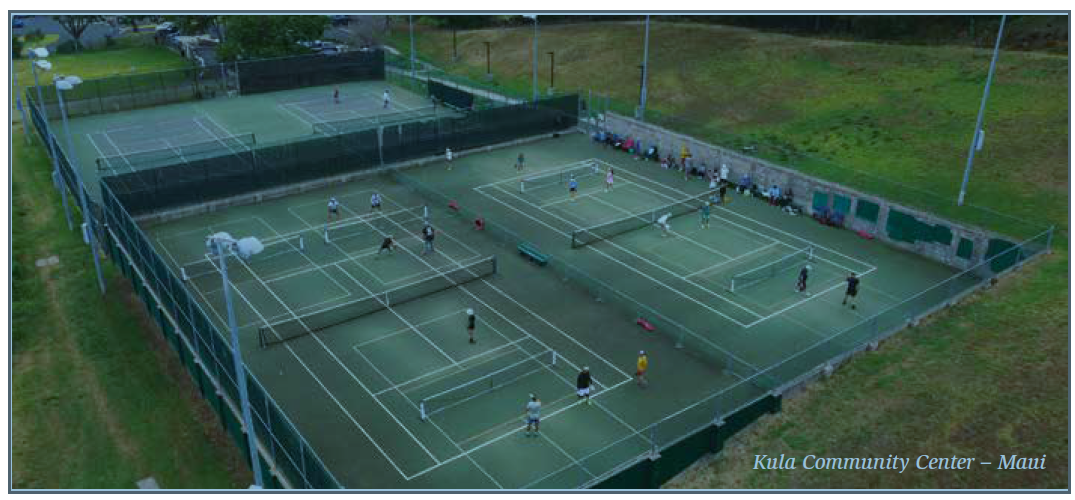
NATIONWIDE
USA Pickleball (National Governing Body) usapickleball.org
• usapickleball.org/about-us/contactus/
• facebook.com/usapickleballassociation
• Places to Play: places2play.org/state/hawaii
O‘AHU
Oahu Pickleball Association (Club) oahupickleballassociation.org
• oahupickleballassociation.org/contact/
• instagram.com/oahupickleballassociation/
• Where to play: bit.ly/OPA-PickleballCourtsMap meetup.com/Oahu-Pickleball-Association
Japan Hawaii Pickleball Association (Club)
japanhawaiipickleballassociation.org/
• aloha@japanhawaiipickleballassociation.org
• facebook.com/aloha.jhpa
• Places to Play: japanhawaiipickleballassociation.org/hawaii
Kailua Pukaball Ohana (Club)
• facebook.com/pilahi.gregg.3
City and County of Honolulu (Dept. of Parks & Rec.) honolulu.gov/parks
• 808-768-3003 | parks@honolulu.gov
• facebook.com/honolulu.parks
• instagram.com/honolulu_parks/
• Where to play: bit.ly/honolulu-gov-pickle-ball-courts
MAUI
County of Maui (Dept. of Parks & Rec.) mauicounty.gov/119/Parks-Recreation
• 808-270-7230 | parks.dept@mauicounty.gov
• Where to play: Call for locations
Aloha Pickleball Complex (Future Facility) Maui Research & Technology Park, Kihei, Maui
alohapickleball.com
BIG ISLAND
Kona Pickleball Hui (Club) konapickleballhui.weebly.com
• konapickleballhui@gmail.com
• Where to play: bit.ly/KPH-PickleballCourtsMap
Old Kona Airport, 75-5530 Kuakini Hwy., Kailua-Kona
Big Island Rogue Pickleball Hui (Club) bigislandroguepickleballhui.com
• bigislandrph@gmail.com
• facebook.com/groups/bigislandroguepickleballhui
• instagram.com/bigislandroguepickleballhui/
• Where to play: Details online
Holua Racquet & Paddle (Facility) holuaracquetandpaddle.com
• 808-989-4611 | holuaracquetandpaddle@gmail.com
• Where to play: 78-7190 Kaleiopapa St, Kailua-Kona
KAUA‘I
Pickleball Association Kauai (Club)
• pakauai.org
• facebook.com/PAKauai
• instagram.com/pakauai808/
• Where to play: pakauai.org/court-locations
County of Kaua‘i (Dept. of Parks & Rec.) kauai.gov/Parks
• 808-241-4460 | parks@kauai.gov
• Where to play: Call for locations
PICKLEBALL PROFILES
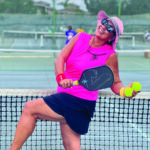 Lani Larrua
Lani Larrua
When her husband of 38 years passed away, Lani found that her social life changed. Six years ago, she started playing pickleball on the private courts at Waikoloa Village, where she lives on the Big Island. A pastor and sworn chaplain for the Hawai‘i Police Department, Lani observes that for some people, playing pickleball has “almost taken the place of going to church” as a way of finding new social networks among kind and accepting people. She describes the game as a cross between ping pong, badminton and tennis and attributes the “weird” rules to the game’s origins as a family game. Family play is growing on the Big Island and it’s a great way for kids to “see a whole other side of their parents — having fun, laughing, not always winning. Pickleball is healthy, good, fun behavior. It keeps the body moving. A body in motion is a body alive.” And “killing the ball” gets rid of stressors!
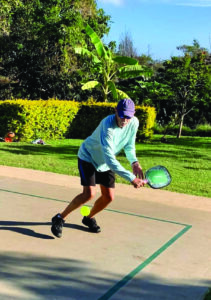 Todd Richter
Todd Richter
Todd was first introduced to pickleball in the mid-1980s. A friend he played tennis with invited him to play at the court her parents had built in their backyard. He liked the game and played it almost weekly, but the parents sold the property a year later and it wasn’t until 2016 that Todd became heavily involved with it. By then, he was working for the County of Maui Department of Parks & Recreation and a visitor called to inquire about places to play pickleball, offering to give free lessons. It soon became obvious the county needed to cater to a growing demand for places to play and Todd helped facilitate that. He retired in 2020, and enjoyed playing pickleball competitively in tournaments. “Over the past couple years, I’ve felt my urge to play tournaments kind of disappear. What keeps me playing now is for fresh air and exercise, and for fun. Because pickleball is fun to play.”
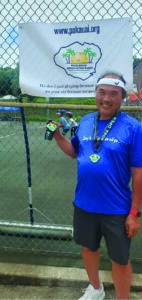 Nolan Ahn
Nolan Ahn
Nolan Ahn is the founding president of the Pickleball Association Kauai (PAK). In his March 2023 President’s Report on the PAK website, he gives an account of the “demise of my hiking days” on account of his two replacement hips and having “unsure feet.” Neither of those two byproducts of aging have kept him from pickleball. Nolan enjoys the competitive side of the game and is looking forward to competing nationally as a “super senior” in the age 75-79 bracket. “Everybody has health issues as they age, so the playing field levels out.” He has already gold medaled in state tournaments in younger brackets. Age brackets put a positive spin on getting older. “Just hang in there… soon you’ll be the youngest in a new bracket.” He is also proud that PAK is a participating Blue Zones organization “supporting healthy lifestyles as we age.”
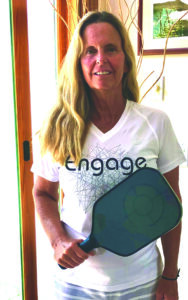 Margie Katras
Margie Katras
Margie was a tennis player and coach but found that she wasn’t learning any more and that injuries were making the game less pleasurable as she aged. She was watching some other people play pickleball at the tennis courts one day and decided to try it. “Just one game and I was hooked! It was like beginning a new life just as my tennis life was coming to an end. It’s easy to learn and you meet a lot of people from different backgrounds.” She now coaches pickleball and describes the gameplay as “cat and mouse,” requiring players to stay focused. Margie admits that tennis is still her No. 1 love, and looks forward to the day when there are more courts dedicated to pickleball so the two sports don’t have to compete for space and time. “It’s like the difference between skiers and snowboarders,” she says. Ski field operators soon realized they had to provide dedicated runs for the new sport.

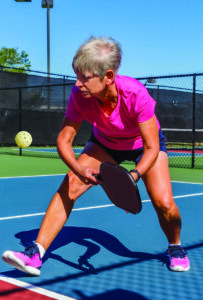
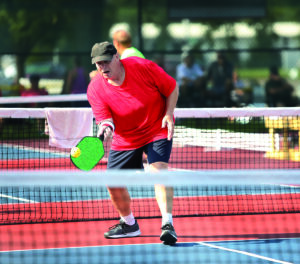
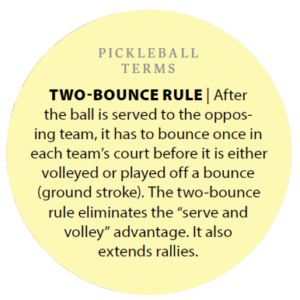
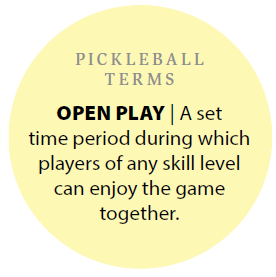
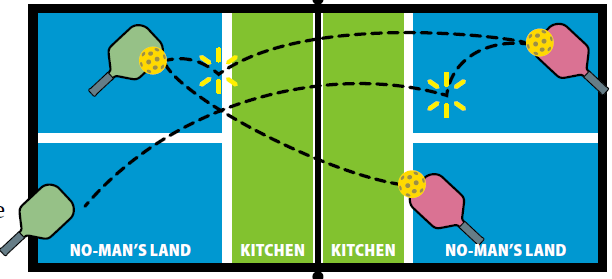
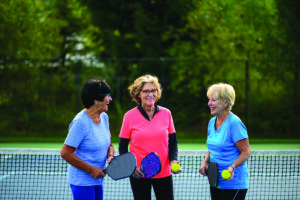
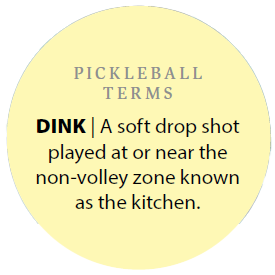

Leave a Reply